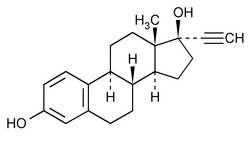Ethinyl Estradiol
(eth' i nil es'' tra dye' ol).
19-Norpregna-1,3,5(10)-trien-20-yne-3,17-diol, (17
19-Nor-17
» Ethinyl Estradiol contains not less than 97.0 percent and not more than 102.0 percent of C20H24O2, calculated on the dried basis.
Packaging and storage—
Preserve in tight, nonmetallic, light-resistant containers.
Completeness of solution—
Dissolve 100 mg in 5 mL of alcohol: the solution is clear and free from undissolved solid.
Identification—
B:
Utraviolet Absorption  197U
197U —
—
Solution:
50 µg per mL.
Medium:
alcohol.
Absorptivities at 281 nm, calculated on the dried basis, do not differ by more than 3.0%.
Melting range  741
741 :
between 180
:
between 180 and 186
and 186 . It may exist also in a polymorphic modification, melting between 142
. It may exist also in a polymorphic modification, melting between 142 and 146
and 146 .
.
Specific rotation  781S
781S :
between
:
between  28.0
28.0 and
and  29.5
29.5 .
.
Test solution:
4 mg per mL, in colorless pyridine from a freshly opened container.
Loss on drying  731
731 —
Dry it at 105
—
Dry it at 105 for 3 hours: it loses not more than 1.0% of its weight.
for 3 hours: it loses not more than 1.0% of its weight.
Assay—
Mobile phase—
Prepare a filtered and degassed mixture of water and acetonitrile (1:1). Make adjustments if necessary (see System Suitability under Chromatography  621
621 ).
).
Internal standard solution—
Prepare a solution of ethylparaben in a mixture of water and acetonitrile (1:1) containing about 0.5 mg per mL.
Standard preparation—
Transfer about 10 mg of USP Ethinyl Estradiol RS, accurately weighed, to a 50-mL volumetric flask, and add 10 mL of Mobile phase. Add 5.0 mL of Internal standard solution, dilute with Mobile phase to volume, and mix to obtain a solution having a known concentration of about 0.2 mg of USP Ethinyl Estradiol RS per mL.
Assay preparation—
Transfer about 25 mg of Ethinyl Estradiol, accurately weighed, to a 25-mL volumetric flask, add Mobile phase to volume, and mix. Transfer 10.0 mL of this solution to a 50-mL volumetric flask, add 5.0 mL to Internal standard solution, dilute with Mobile phase to volume, and mix.
Chromatographic system
(see Chromatography  621
621 )—The liquid chromatograph is equipped with a 280-nm detector and a 4.6-mm × 15-cm column that contains packing L1. The flow rate is about 1 mL per minute. Chromatograph the Standard preparation, and record the peak responses as directed under Procedure: the resolution, R, between the analyte and internal standard peaks is not less than 4.5, and the relative standard deviation for replicate injections is not more than 2.0%.
)—The liquid chromatograph is equipped with a 280-nm detector and a 4.6-mm × 15-cm column that contains packing L1. The flow rate is about 1 mL per minute. Chromatograph the Standard preparation, and record the peak responses as directed under Procedure: the resolution, R, between the analyte and internal standard peaks is not less than 4.5, and the relative standard deviation for replicate injections is not more than 2.0%.
Procedure—
Separately inject equal volumes (about 25 µL) of the Standard preparation and the Assay preparation into the chromatograph, record the chromatograms, and measure the responses for the major peaks. The relative retention times are about 0.6 for ethylparaben and 1.0 for ethinyl estradiol. Calculate the quantity, in mg, of C20H24O2 in the portion of Ethinyl Estradiol taken by the formula:
125C(RU / RS)
in which C is the concentration, in mg per mL, of USP Ethinyl Estradiol RS in the Standard preparation, and RU and RS are the peak response ratios obtained from the Assay preparation and the Standard preparation, respectively.
Auxiliary Information—
Please check for your question in the FAQs before contacting USP.
| Topic/Question | Contact | Expert Committee |
|---|---|---|
| Monograph | Domenick Vicchio, Ph.D.
Senior Scientific Liaison 1-301-998-6828 |
(SM42010) Monographs - Small Molecules 4 |
| Reference Standards | RS Technical Services 1-301-816-8129 rstech@usp.org |
USP35–NF30 Page 3126
Pharmacopeial Forum: Volume No. 37(3)

